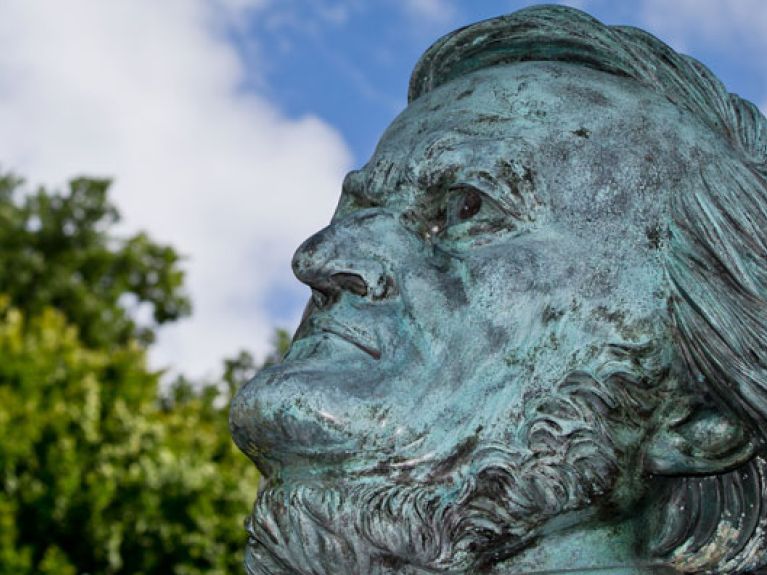Wagner Year
He is loved and hated, he is a musical innovator. Richard Wagner was born 200 years ago.

The chapter on Richard Wagner in the book about great composers written by American music critic and journalist Harold C. Schonberg is boldly entitled Colossus of Germany. Even if Schonberg wrote a lot of negative things about the composer’s character, which tended in every sense towards the hypertrophic, nevertheless, the intimidating designation “Colossus” was intended more as a compliment. Richard Wagner was born in Leipzig in 1813 and died in 1883. Both for his contemporaries and for later generations, there was something overwhelming about Wagner, not just his personality, but also his oeuvre. Quality and quantity of artistic production come together in Wagner to a greater extent than in any other composer in the history of music. Wagner fascinated, and still fascinates, the world by means of masses and power – to paraphrase Elias Canetti. Anyone who has ever completed the quasi-religious exercise which attending a performance of the whole Ring of the Nibelungen in Bayreuth involves, will gladly confirm this judgement on the “Colossus of Germany”.
There are great composers who have gained a place in the history books without really making any innovative formal, technical or aesthetic contributions. The most important of these was possibly Mozart, a consummator and preserver, in other words, a classic. Richard Wagner is regarded as an innovator per se. For which reason he was not only loved, admired and revered, but also hated, above all by conservatives. The concept of the subversive renewer, however, ought perhaps to be relativized. By definition, everything new is rooted in the old, linked with it through criticism or reaction. Often, something singularly old forms the basis for something exemplarily new, thereby giving rise to a new tradition.
Euryanthe, the opera by Carl Maria von Weber, had largely replaced stereotypical opera, with its recitative and arias, by a through-composed score. Wagner quite simply made this idea the principle of his music dramas. Weber and other composers used musical quotation for the purposes of reminding audiences. Wagner shaped his whole Ring tetralogy out of that kind of harmonic-melodic recurrence, which he called a Leitmotif. The idea of a Gesamtkunstwerk, the interweaving of music, painting, theatre, dance, poetry and music, had been the real impulse behind the opera genre since its beginning in the circle of the Florentine Camerata around 1600. Wagner’s music drama, however, achieved something like the annihilation of artistic individuality, the synthetic blending of his work’s different expressive forms, whereby as early as Lohengrin he had already used the coloristic dimension of the orchestra as a compositionally relevant principle in his instrumental sound mix.
Anyone wishing to understand the musical trends of the 20th century, their radical rejection of traditional compositional forms, and in doing so understand “how it all began”, will have to go back to the oeuvre and the artistic ideas of the Praeceptor Musicae in Bayreuth. Modernism in the emphatic sense begins with Richard Wagner. And one of the fascinating aspects of such moments in music history is that this beginning is manifest in a single chord: the so-called Tristan chord.
With Tristan and Isolde, which the composer himself designated as a “plot” (Handlung) and not a drama, music drama or even an opera, Wagner’s melodics and harmonics simultaneously expanded into an artistic surge of transitions and nuances, the impact of which can be felt in the work of an Arnold Schönberg and the compositional ideas of a György Ligeti. The hostilities to which both work and composer were exposed after Tristan and Isolde, the most static of all operas and yet one that describes like no other the protagonists’ inner turmoil while exposing layers of the unconscious, have long since given way to its assessment as one of the greatest ever works of music drama. At the same time the aversions which the work gave rise to in contemporaries like Clara Schumann are grounded in the very dimensions of the composition itself. An opera of comparable size, intensity, harmonic complexity, equivalent instrumentation, sensuality, mythological force and imagination had not existed before Tristan and Isolde. Wagner overtaxed his contemporaries with it, but not the musicians of subsequent generations.
The dissolution of functional harmony in European classical music begins in the Tristan chord, with its F, B, D sharp and G sharp. This is a chord whose tendency remains unclear, which disrupts the thrust of the tones and on which to this very day the experts are not agreed as to whether it is rooted in A minor or F sharp minor. Also unclear is whether the G sharp could be understood as an appoggiatura moving to an A, making it a diminished seventh, whether it is a double leading-tone cadence, an atonal chord or – to quote Schönberg – a “wandering chord” that questions the system of tonal harmonics and represents the first step towards the emancipation of dissonance: a harmonic transgression with an expressive impact. August Everding believed, with some justification, that the beginning of Wagner’s Tristan and Isolde – the chord first sounds on the second bar of the overture – marked the beginning of modernism in music, just as Baudelaire’s Les fleurs du Mal marked the beginning of modernism in literature.
The fact is that on the global musical landscape Richard Wagner represents a conspicuous monolith whose creativity includes the spectacle and the speculative, to say nothing of self-presentation. For this reason Wagner was to a certain degree also fighting himself when he described the work of his composer colleague and generous patron Giacomo Meyerbeer as being an “effect without a cause”. Yet justice certainly cannot be done to Wagner’s gigantic oeuvre by relativizing it on the basis of the composer’s attitudes to those around him, his anti-Semitism, his egomania and his exaggerated sense of mission, in other words: the man himself and all his contradictions.
An immense monolith on the music theatre landscape is the Festspielhaus in Bayreuth, which to this very day is devoted exclusively to interpreting Wagner’s own works. Wagner’s engagement with the philosophical and social movements of his day, with Bakunin and Nietzsche, Schopenhauer and German mythology, along with his controversial aesthetic and ideological theses, are an inviolable part of the history of European ideas. All the more so as the complex oeuvre and complex personality of Wagner – which are sometimes also a source of irritation – still spur us as no other composer in history does to reflect and to add to the volume of secondary literature on him.
Anyone lecturing on Wagner now must therefore be aware of the fact that, according to the Wagner-exegete Helmuth Weinland, they can at most only be making marginal notes. ▪
Prof. Dr. Wolfgang Sandner, Wagner expert and famous music critic, was an editor of the Frankfurter Allgemeine Zeitung, for which he still writes. He teaches in Marburg.

